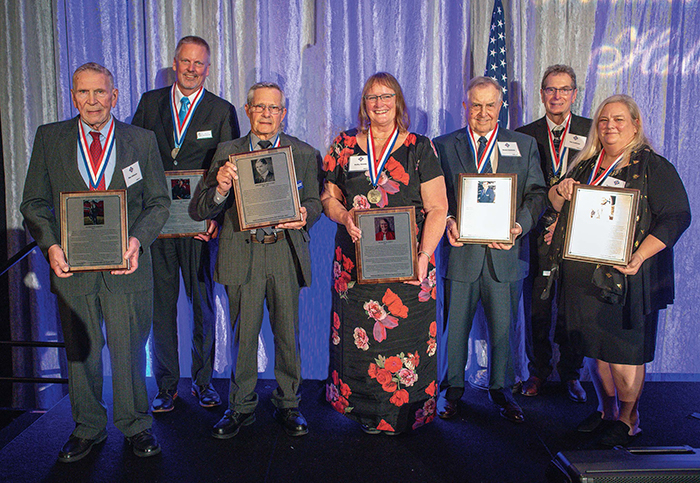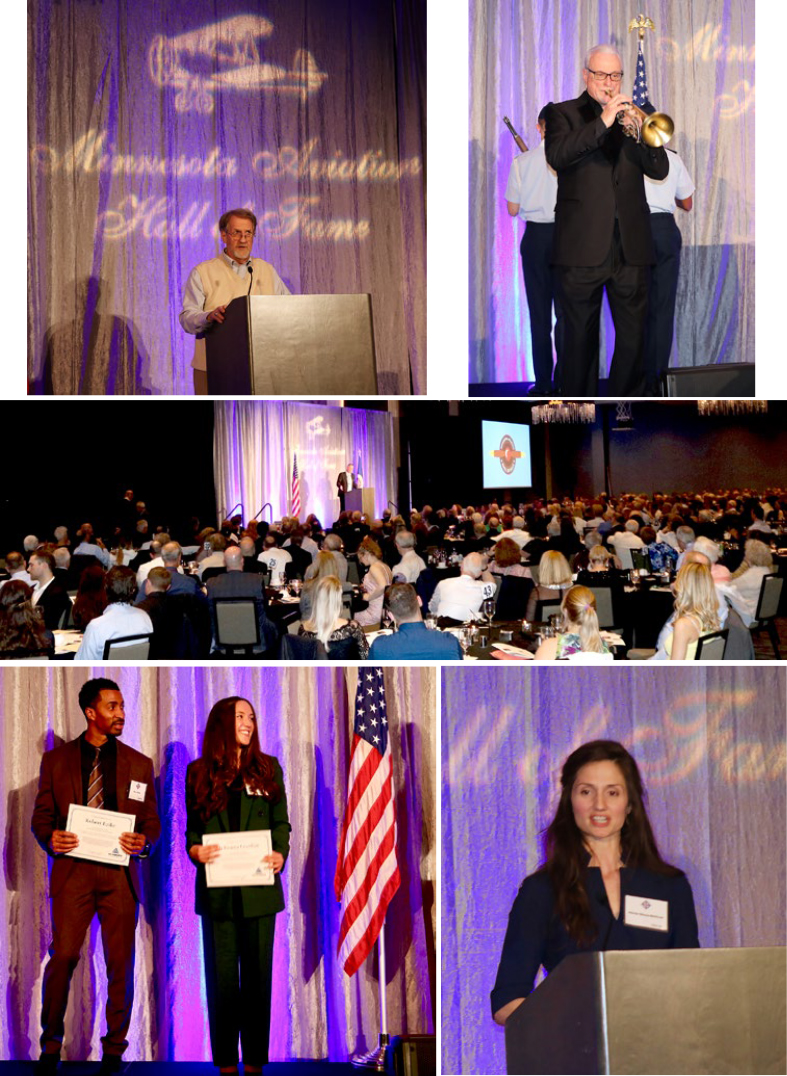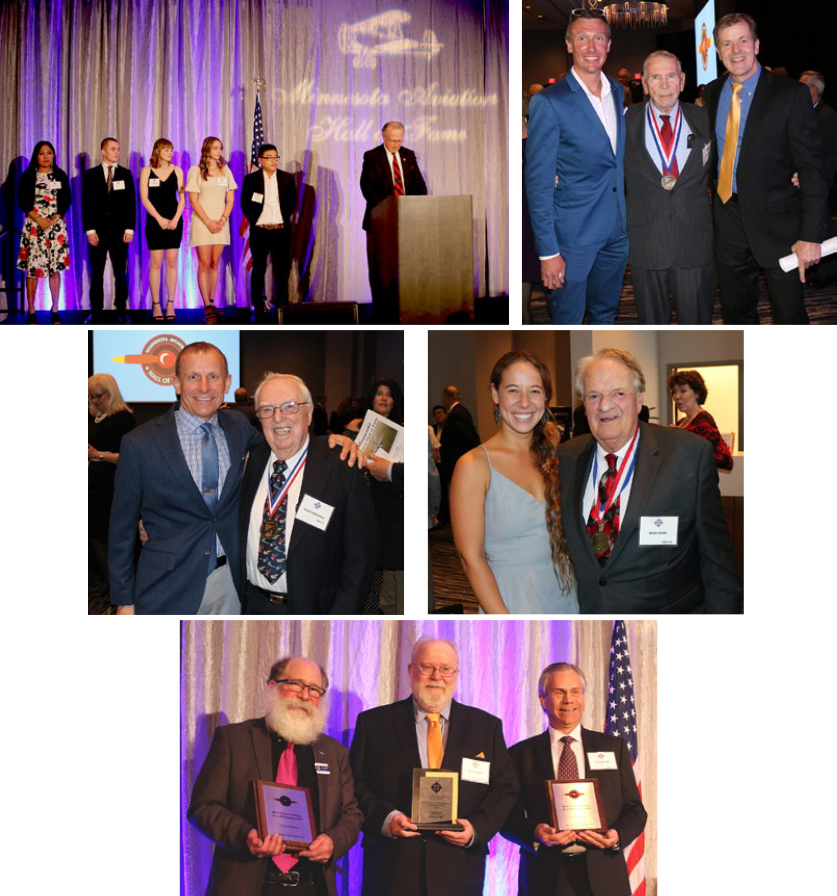
Published in Midwest Flyer Magazine June/July 2022 Digital Issue
The 2022 Minnesota Aviation Hall of Fame banquet was held April 23, 2022, at the InterContinental Minneapolis – St. Paul Airport (KMSP) Hotel, only six (6) months after the organization’s 2021 banquet, due to rescheduling in 2021 because of the pandemic. Inductees included Ray Johnson, Ezra Benham “Ben” Curry, Duane Edelman, Kathy Vesely, Dale Klapmeier, Martin Knutson, and Tim Callister.
Raymond W. Johnson was born and raised in Pine City, Minnesota. After high school he attended Gale Institute in Minneapolis, where he learned telegraphy and railroad communications. He furthered his education at Northwest Electronics in Minneapolis, receiving his Second-Class FCC license. He received an A&E from Vocational Training School in Janesville, Wisconsin. In 1951, Johnson went to work for the Union Pacific Railroad in Denver, Colorado as a telegraph operator and station agent. Serving in the U.S. Army from 1953-54, he had additional training in Morse Code. Following the service, he earned his Private Pilot Certificate in 1958, and his Instrument Rating at Embry-Riddle University in Miami, Florida. In 1958, Johnson went to work for Jamestown Flying Service as an Airframe & Powerplant Mechanic and flew powerline patrol and aerial application. He eventually ended up as a corporate pilot with Franklin Manufacturing, Sterner Lighting and finally, Kurt Manufacturing, where he spent 31 years (1966-97) flying nationally and internationally. Between his commercial flying as both a corporate pilot, and as a flight instructor at Minneapolis Crystal Airport and Buffalo Municipal Airport, and flying his own airplanes for recreation, Johnson amassed over 18,000 hours.
Ezra Benham “Ben” Curry (1896 – 1991) was born in St. Paul, Minnesota. He began his career as a railroad locomotive cleaner and was recruited as a civilian in 1917 by the Norton-Harjes Ambulance Service of France to drive battlefield ambulances. He had hoped to join the French Army but returned to St. Paul later that year when the ambulance service was disbanded. Curry then returned to St. Paul and enlisted in the U.S. Army Signal Corps Reserve, where he soloed a Curtiss Jenny in 1918 and served as an engineer.
In 1942, Curry was hired by Northwest Airlines and became the General Manager of Northwest Airlines’ Vandalia, Ohio B-24 Modification Center. In 1944, he was transferred to the Holman Field, St. Paul Modification Center. Under his supervision, B-24s were retrofitted with radar units, and converted to tankers and camera ships. In 1946, following the war, Curry worked for Northwest Airlines as the contract manager at the Boeing plant in Seattle to build B-377 Stratocruisers. When he returned to Minnesota, he became the supervisor of line maintenance, and in 1951, he became manager of the mechanical division. In 1952, Curry resigned to work at the family lodge in Brainerd.
Duane V. Edelman (1941 – ) grew up on a dairy farm near Clintonville, Wisconsin and enlisted in the U.S. Air Force straight out of high school in 1959. There, he became an aircraft crew chief, eventually maintaining F-100s for the U.S. Air Force Thunderbirds demonstration team.
Edelman moved to Sioux City, Iowa to learn to fly and received his Commercial Pilot Certificate in 1964. He flew skydivers and made mortuary flights to build time, receiving his Airline Transport Pilot Certificate in 1966. He was hired by North Central Air Lines and flew DC-3s, the very aircraft and airline that had inspired him as a child. He lived in Minnesota and worked for the airline for 38 years through its mergers with Republic and Northwest, flying the Convair 440 and 580, DC-9, and Boeing 727, 757 and 747.
At the time of the Republic Airlines and Northwest Airlines merger, Edelman was Director of Flight Operations, while continuing to fly the line. Northwest then appointed him Director of Flight Technical, where he worked on the implementation of the electronic flight bag, electronic clearance, and taxi clearance. He was then appointed Temporary Vice President to become Chairman of the SAE S7 Committee for the International Air Transport Association (IATA), writing guidelines for international operations. For this work, Northwest Airlines awarded him the “President’s Award.”
After retiring from Northwest Airlines, Edelman started his own company, Aircraft Data Fusion. The company worked on launch and recoverable space vehicles for the X-Prize competition, and with Honeywell on human factors. He worked on the concept of Free Flight, which would allow aircraft to control themselves to separate from other traffic, and the integration of supersonic aircraft into an airline operation (www.aircraftdf.com).
Kathleen R. Vesely (1954 – ) of Golden Valley, Minnesota, was born in Bemidji, Minnesota. She got her first airplane ride from an itinerant seaplane pilot at the city’s seaplane docks on Lake Bemidji in 1964. She went to college in Bemidji, where she studied Geology and Geography, and Planning and Environmental Studies. She began her career working for the Minnesota Department of Transportation (MNDOT) in Bemidji on highway construction planning and surveying, and later transferred to MNDOT’s St. Paul office.
In 2002, after 20 years working on roads, she transferred to the Aeronautics Office where her knowledge of geology, geography and environmental issues made her a natural for the job. Vesely was able to guide airport operators with their planning and compliance with MNDOT funding requirements. Her skills in coordinating the two elements – funding and airport needs – were central to her ability to get things done. She emphasized long-range planning, allowing both funding agencies and airports to see 10 or 20 years into the future.
Vesely was appointed Assistant Aeronautics Director under Cassandra Isackson. She then canvassed every airport in Minnesota to help determine their future needs. The FAA was so impressed with her work that the agency allowed her to coordinate Minnesota airports with federal funding needs.
Vesely retired from MNDOT in 2020 after 41 years of service, including 18 years with the Minnesota Office of Aeronautics. She and her husband own and fly a Cessna Cardinal.
Born in DeKalb, Illinois, Dale E. Klapmeier (1961 – ) attended the University of Wisconsin-Stevens Point, graduating with degrees in Business Administration and Economics. Growing up he built model airplanes, frequented the local airport, and dreamed of designing his own airplane. He started flying at age 15 in a Cessna 140 he and his brother, Alan, bought together. The brothers then rebuilt a wrecked Aeronca Champion and built a Glasair homebuilt aircraft.
In 1984, the Klapmeier brothers founded Cirrus Design Corporation in the lower level of their parents’ rural dairy barn. Their first design was the VK30, a pusher-type aircraft, which they built at their Baraboo, Wisconsin facilities. Along with their aircraft designs, the Klapmeiers pioneered an emergency parachute recovery system for aircraft, designed to lower a nonfunctioning aircraft to the ground, saving the lives of its occupants. The concept has also become a major marketing tool.
In 1998, the Cirrus SR20 was certified, followed by the SR22 in 2000. The company soon outgrew their Baraboo, Wisconsin facilities and moved to Duluth International Airport in Minnesota, and later established another facility in Grand Forks, North Dakota. The SR20 and SR22 feature all-composite airframes, full glass cockpits and side-stick controls. By 2003, the SR22 had become the top-selling general aviation aircraft in the world! The company’s most recent design – the SF50 Vision Jet – was certified in 2016. In 2011, Cirrus was sold to China Aviation Industry General Aircraft (CAIGA), but Dale Klapmeier remained the company’s CEO until 2019.
Martin Knutson (1930 – 2013) was born in Minneapolis, Minnesota. He graduated from St. Louis Park High School and attended the University of Minnesota, majoring in Electrical Engineering in the Navy’s Holloway Plan, which was a program that paid for college while the student served in the military. While working in the Pacific Fleet during the summer of 1949, Knutson took his first airplane ride in the ball turret of a Grumman TBM Avenger. It was after that flight that Knutson decided it would be better to be in the cockpit where the controls were.
In 1950, Knutson transferred to the Air Force for flight training, where he trained in the T-28 and F-80A. Upon graduation, he was assigned to a jet fighter squadron and deployed to Korea where he flew combat missions in the F-80 and F-86. Following Korea, Knutson was assigned to the Strategic Air Command (SAC) as a fighter pilot stationed at Turner AFB, Georgia, where he flew the Republic F-84, training for long-range nuclear strike missions. In 1955, Knutson volunteered for assignment to the Central Intelligence Agency (CIA) where he participated in the flight testing of the Lockheed U-2, nicknamed “Dragon Lady,” a single-engine, high-altitude jet reconnaissance aircraft. He was then deployed to Europe and flew missions over the Soviet Union. Knutson continued to fly covert missions over ‘denied territory’ throughout the world until his retirement from the Air Force in 1970.
Following his retirement, Knutson joined the National Aeronautics and Space Administration (NASA) Ames Research Center in California as Manager of Earth Resources Projects. There he helped develop airborne remote sensing equipment for observation satellites. He helped modify U-2 aircraft for earth-sensing missions regarding sea and land ice, wildlife habitat, ozone depletion, air pollution, typhoon dynamic structure, and other environmental projects.
Knutson moved on to become the NASA Site Manager at the Dryden Test Flight Facility. This was during the beginning of the Space Shuttle program when most of the Shuttle landings were made at Edwards Air Force Base. At Dryden, he participated in many unique test programs and was responsible for NASA obtaining three SR-71 aircraft for environmental missions, after the Air Force had retired them. At the age of 67, Knutson flew an SR-71 to a speed of Mach 3.275. He retired from NASA in 1997. Knutson served a combined 47 years with the Air Force, CIA, and NASA. He amassed over 4000 flight hours in the U-2 during his 29 years flying the aircraft.
A native Minnesotan, Timothy C. Callister (1947 – ) was born in Owatonna and raised on a farm in West Concord. At the age of 7, he decided he wanted to be an airline pilot. As a gift from his parents, he experienced his first airplane ride on a North Central Airlines flight from Minneapolis to Rochester. Callister later decided he wanted to become a Department of Natural Resources Conservation Officer; however, world events disrupted that plan. The U.S. involvement in Vietnam was escalating and in 1968, Callister joined the U.S. Army. As a Warrant Officer, he served in the 189th Assault Helicopter Company in Vietnam. During his time in Vietnam, Callister was awarded the Distinguished Flying Cross for his heroic actions in suppressing heavy enemy fire during a rescue mission. He was also awarded the Bronze Star and the Air Medal.
Following his service in Vietnam, Callister returned to Minnesota and attended St. Cloud State, graduating with a degree in Transportation and Urban Planning. While attending the university, he joined the Minnesota Army National Guard and became a helicopter instructor for the 47th Aviation Battalion, St. Paul, and as a member of the 2-147th Aviation Battalion, State Area Readiness Command. He retired from the National Guard in 1991.
In 1974, Callister joined the Metropolitan Airports Commission (MAC) and interned in the planning and engineering department, eventually becoming the Manager of the Reliever Airport System, responsible for six general aviation airports, with 750,000 operations a year. In 1986, he became the Minneapolis-St. Paul International Airport Assistant Airport Director. In 1996, Callister moved into the Airport Director’s position, overseeing 250 airport staffers, and was involved in planning, designing and implementation of a $3.1 billion expansion and upgrade to the airport.
In 2004, Callister retired from the Metropolitan Airports Commission and joined Mead & Hunt as a Senior Project Planner for Aviation Services. He also cofounded the Minnesota Council of Airports (MCOA). Callister is also a member of the American Association of Airport Executives (AAAE), and the Vietnam Helicopter Pilots Association in which he served as President of the Upper Midwest Chapter from 2019 to 2020.
Tim Callister has spent his retirement promoting airport matters in Minnesota by speaking on their behalf, serving as an airport tour guide, and mentoring aviation students in finding careers in the airport industry.

Prior to the induction ceremonies, several scholarships were presented, including two “Sherm Booen Legacy Scholarships” in the amount of $5,000.00 each, sponsored by Academy College, located in Bloomington, Minnesota. Recipients included Robert Ezike and McKenna Gordon.
To hear the McKenna Gordon and Robert Ezike podcast on the “World of Aviation,” go to: https://am1280thepatriot.com/radioshow/world-of-aviation

Other scholarships included the “Gift of Wings, Elizabeth Betty Wall Strohfus Aviation Scholarship” presented to Samantha Naples; “Hinz Family Red Tail Scholarship” presented to Jessica Stelton; “Brig. Gen. George Schulstad Scholarship” presented to Jacob Helvick; “Kenneth Dahlberg Family Scholarship” presented to Shoua Vang; and “Minnesota Aviation Hall of Fame Scholarship” presented to Anjhain Ryan.
The master of ceremonies for the event was Al Malmberg, host of the radio program “World of Aviation.” The program is sponsored by Academy College and Thunderbird Aviation and is heard each Sunday morning at 10:05 a.m. (CT) on am1280ThePatriot.com (www.academycollege.edu and www.thunderbirdaviation.com). MAHF Board
Member Stan Ross narrated each recipient’s audio visual.
The MAHF Board of Directors include Noel Allard, Chairman; Terry Baker, Vice Chairman; Carol Cansdale, Secretary; Amelia Halsted, Treasurer; Tim Barzen; Thomas Lymburn; Brandon Montanye; Cheri Rohlfing; Stan Ross; Tom Schellinger; Jim Hanson; and Mary Alverson.
Minnesota Aviation Hall of Fame sponsors include the MSP Airport Foundation (Foundation Sponsor), Delta Air Lines (Forever In-Flight Sponsor), Cirrus Aircraft and Signature Flight Support (Jet-Setters Sponsors), Aircraft Owners & Pilots Association (AOPA) and Wipaire, Inc. (Pioneer Sponsors), and JETPUBS, Inc. and Wings of the North (In-Kind Contributors).
The 2023 Minnesota Aviation Hall of Fame will be held in April 2023 (www.mnaviationhalloffame.org).
Any photos without credit are those of Randy Arneson/Midwest Flyer Magazine.